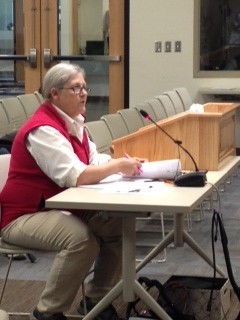A state Department of Corrections plan to release non-violent prisoners and put them on electronic monitoring has raised alarm in Palmer. The community is home to the Palmer Correctional Center, and some residents fear there is not enough supervision available to support the move. A state legislator held a field hearing on Tuesday to gauge public reaction to the plan.
The state Department of Corrections wants to release 176 inmates to an ankle monitoring plan. Corrections department commissioner Ron Taylor says the plan is driven by both state budget cuts, and by a move toward prison reform.

“The department has been focused on successful prisoner re-entry. And so what we are trying to do is look for ways that we can assist people to be more successful so that they are not a public safety risk, or we lessen the public safety risk when they return to the community. ”
Taylor told the panel that it is not correct to term the plan “early release”, nor will it empty out the Palmer facility.
“The Palmer Ramp Down, as it is being referred to, is not necessarily the ramp down of Palmer minimum, or the closure of Palmer medium. It’s actually looking at all our minimums across the state to determine who can we allow to serve their sentence on electronic monitoring or halfway house, or some other fashion.”
Taylor says legislative leadership has contacted his department to find ways to reduce inmate populations by 15 percent, then up to 25 percent to save costs. Taylor says corrections is already working toward that goal, with more than one thousand prisoners now on electronic monitoring or in halfway houses in eight communities in the state He told the panel that a prisoner in a “hard bed” or one housed in a state facility, costs 142 dollars a day. That pencils out to about 50 thousand dollars a year for each prisoner. Taylor said ankle monitoring costs a little over $22 a day for each prisoner.
But Representative Jim Colver, who called for and chaired the field hearing, had concerns about the criteria used to determine inmate eligibility for the monitoring plan, and about it’s effectiveness
“A lot of other states have budget reductions and have gone through these kinds of things. From some of the information that I’ve gathered an inmate put the monitor on his dog and then went out and offended. The corrections department [in Colorado] went through a third party vendor and they thought the inmate was still in the house where he was detained, but he was out committing crimes.”
Taylor told him that corrections does not use third party vendors, and currently has 446 inmates on electronic monitoring supervised by DOC.
Public Safety commissioner Gary Folger also cited other state’s problems with ankle monitoring. He said a Los Angeles county program failed to provide enough probation officers, while homelessness there shot up.
“The liason told me the population of skid row had tripled. What I am saying here is that it [affects] more than just one department. ”
Others at the hearing voiced community concerns. Vicki Wallner, who maintains the anti -crime website Stop Valley Thieves, says if offenders don’t do actual prison time, they will re-offend
“And this is why people are so angry. We’re seeing people that are convicted of vehicle thefts, of burglary, and these people are walking back on the street within a year.”
But Taria Walters, a former inmate at Hiland Mountain, supports the monitoring plan.
“And the reason why I say that is because I have lived within the system and see many individuals that could benefit from getting on the ankle monitor. They could get a job and pay their own rent, pay for the ankle monitor and start paying back the restitution and their fines. ”
Walters also told the panel about the extreme difficulty of finding housing after her release from prison. She has an drug felony on her record, and she said she spent two years in rented rooms or transitional housing before she could find a place of her own to rent.
APTI Reporter-Producer Ellen Lockyer started her radio career in the late 1980s, after a stint at bush Alaska weekly newspapers, the Copper Valley Views and the Cordova Times. When the Exxon Valdez ran aground in Prince William Sound, Valdez Public Radio station KCHU needed a reporter, and Ellen picked up the microphone.
Since then, she has literally traveled the length of the state, from Attu to Eagle and from Barrow to Juneau, covering Alaska stories on the ground for the AK show, Alaska News Nightly, the Alaska Morning News and for Anchorage public radio station, KSKA
elockyer (at) alaskapublic (dot) org | 907.550.8446 | About Ellen




